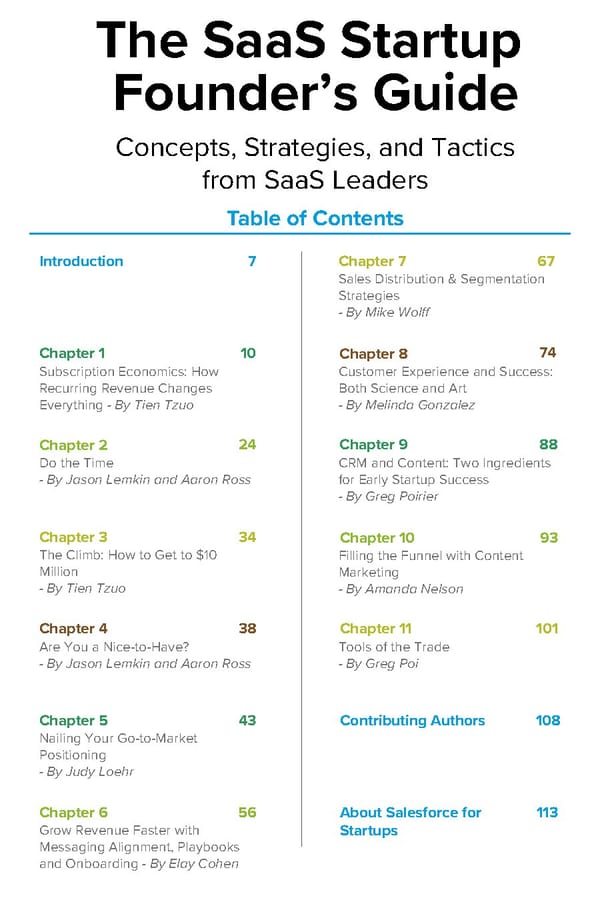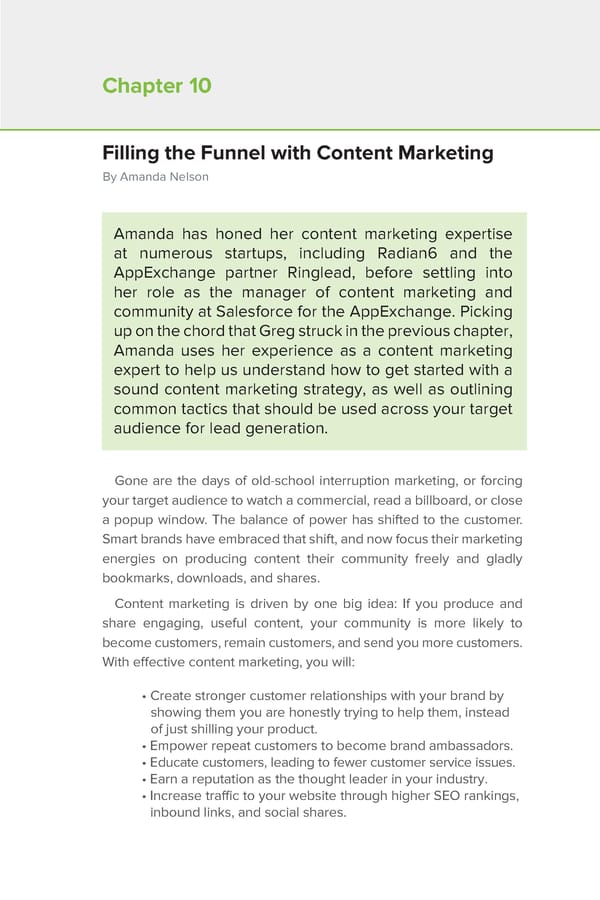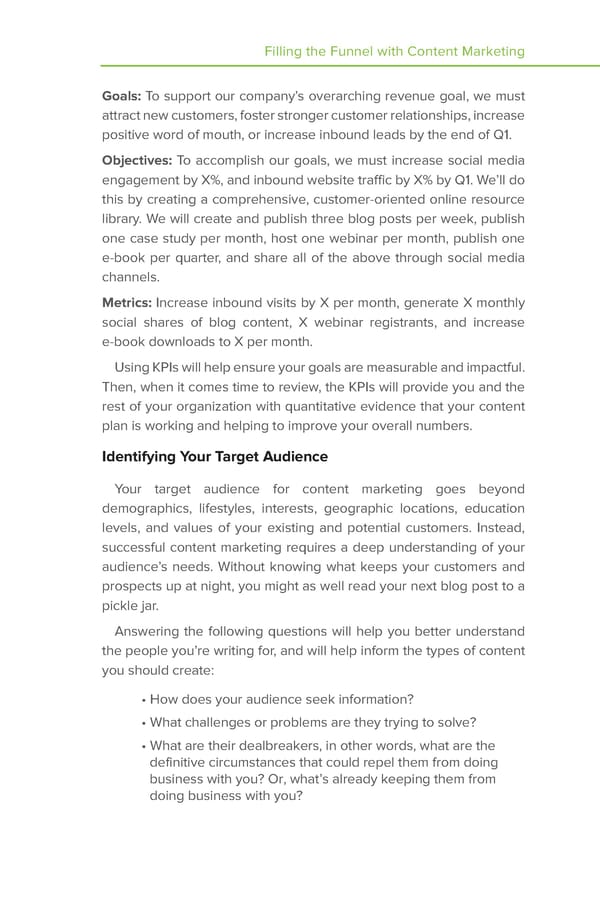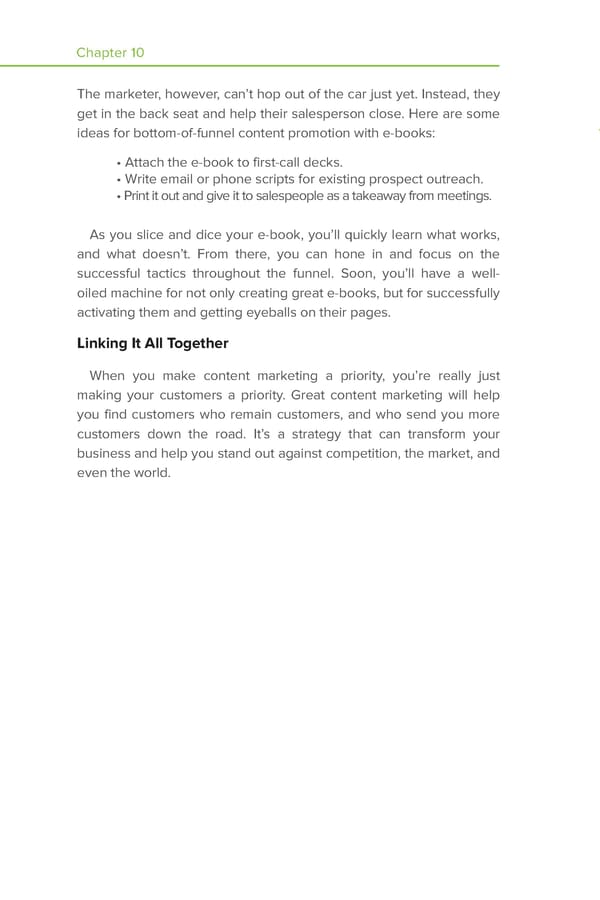Filling the Funnel with Content Marketing
By Amanda Nelson, Senior Director, Community Marketing at Salesforce
The SaaS Startup Founder’s Guide Concepts, Strategies, and Tactics from SaaS Leaders Table of Contents Introduction 7 Chapter 7 67 Sales Distribution & Segmentation Strategies - By Mike Wolff Chapter 1 10 Chapter 8 74 Subscription Economics: How Customer Experience and Success: Recurring Revenue Changes Both Science and Art Everything - By Tien Tzuo - By Melinda Gonzalez Chapter 2 24 Chapter 9 88 Do the Time CRM and Content: Two Ingredients - By Jason Lemkin and Aaron Ross for Early Startup Success - By Greg Poirier Chapter 3 34 Chapter 10 93 The Climb: How to Get to $10 Filling the Funnel with Content Million Marketing - By Tien Tzuo - By Amanda Nelson Chapter 4 38 Chapter 11 101 Are You a Nice-to-Have? Tools of the Trade - By Jason Lemkin and Aaron Ross - By Greg Poi Chapter 5 43 Contributing Authors 108 Nailing Your Go-to-Market Positioning - By Judy Loehr Chapter 6 56 About Salesforce for 113 Grow Revenue Faster with Startups Messaging Alignment, Playbooks and Onboarding - By Elay Cohen
Chapter 9 CRM and Content: Two Ingredients for Early Startup Success Chapter 10 Filling the Funnel with Content Marketing By Amanda Nelson Amanda has honed her content marketing expertise at numerous startups, including Radian6 and the AppExchange partner Ringlead, before settling into her role as the manager of content marketing and community at Salesforce for the AppExchange. Picking up on the chord that Greg struck in the previous chapter, Amanda uses her experience as a content marketing expert to help us understand how to get started with a sound content marketing strategy, as well as outlining common tactics that should be used across your target audience for lead generation. Gone are the days of old-school interruption marketing, or forcing your target audience to watch a commercial, read a billboard, or close a popup window. The balance of power has shifted to the customer. Smart brands have embraced that shift, and now focus their marketing energies on producing content their community freely and gladly bookmarks, downloads, and shares. Content marketing is driven by one big idea: If you produce and share engaging, useful content, your community is more likely to become customers, remain customers, and send you more customers. With effective content marketing, you will: • Create stronger customer relationships with your brand by showing them you are honestly trying to help them, instead of just shilling your product. • Empower repeat customers to become brand ambassadors. • Educate customers, leading to fewer customer service issues. • Earn a reputation as the thought leader in your industry. • Increase traffic to your website through higher SEO rankings, inbound links, and social shares.
Chapter 10 Filling the Funnel with Content Marketing • Create opportunities to engage with prospects seeking to learn more about their buying options. The list above illustrates how content marketing differs from other marketing levers in that the ROI has a long-term impact and is relatively consistent. How to Get Started with Content Marketing Content marketing starts with a desired result in mind. Why are you making content marketing a priority? What do you hope to accomplish? Before you start blogging, tweeting, or creating videos, you need a plan that outlines the following: 1. Specific goals and objectives. 2. The types of content you want to create and distribute. 3. The topics on which you’ll generate relevant content. 4. Which channels you’ll use to publish and share content. 5. The resources required to carry out the plan. Whatever your goals with content marketing, state them clearly in your plan and outline the specific objectives that will help your brand accomplish them. As you’re doing this, use the S.M.A.R.T. strategy to ensure your goals and objectives are: SPECIFIC MEASURABLE ACTIONABLE REALISTIC TIMED It’s easy to get ahead of yourself when planning out a content strategy and thinking long term about all the potential for great content. Make sure in your planning you acknowledge your strengths and weaknesses, recognize your resource limitations, and ensure the goals you set are realistic so that you can clearly define what success looks like for your brand. Doing so will keep you focused on that desired outcome and help you to avoid burnout in the content creation process. Once your goals and objectives are solidified, determine exactly which key performance indicators (KPIs) you’ll use to measure success, and set a benchmark. For example:
Chapter 10 Filling the Funnel with Content Marketing Goals: To support our company’s overarching revenue goal, we must attract new customers, foster stronger customer relationships, increase positive word of mouth, or increase inbound leads by the end of Q1. Objectives: To accomplish our goals, we must increase social media engagement by X%, and inbound website traffic by X% by Q1. We’ll do this by creating a comprehensive, customer-oriented online resource library. We will create and publish three blog posts per week, publish one case study per month, host one webinar per month, publish one e-book per quarter, and share all of the above through social media channels. Metrics: Increase inbound visits by X per month, generate X monthly social shares of blog content, X webinar registrants, and increase e-book downloads to X per month. Using KPIs will help ensure your goals are measurable and impactful. Then, when it comes time to review, the KPIs will provide you and the rest of your organization with quantitative evidence that your content plan is working and helping to improve your overall numbers. Identifying Your Target Audience Your target audience for content marketing goes beyond demographics, lifestyles, interests, geographic locations, education levels, and values of your existing and potential customers. Instead, successful content marketing requires a deep understanding of your audience’s needs. Without knowing what keeps your customers and prospects up at night, you might as well read your next blog post to a pickle jar. Answering the following questions will help you better understand the people you’re writing for, and will help inform the types of content you should create: • How does your audience seek information? • What challenges or problems are they trying to solve? • What are their dealbreakers, in other words, what are the definitive circumstances that could repel them from doing business with you? Or, what’s already keeping them from doing business with you?
Chapter 10 Filling the Funnel with Content Marketing • What are their job responsibilities and what decisions can they make? • How do they measure success? • What are they reading, watching, and downloading? • How do they use social media? Which social networks do they favor? Once you have a more complete picture of your target audience, you can begin to make decisions around the best type of content to create, where to publish that content, and how to promote it. These are all factors that can either significantly improve or decrease the impact content has on your brand. Getting Started with Content Creation Great content marketing does not require a team of content experts, big budgets, journalists, or editors. Successful content marketing addresses the pain points of customers and prospects, and can be handled with minimal resources. Start by strategically creating content that can be adapted and distributed across a variety of mediums. Pre-planning and repurposing content pieces saves on creative costs and increases search engine traffic. Begin with a lead-driving piece of content, such an e-book or a webinar. These assets not only generate leads, but they have legs to become many other forms of content in the future, such as a blog post series, an online course, or a video. Creating Content from Scratch Producing your first e-book can take time, but the amount of content you’ll generate from it will last months, if not the entire year. Consider selecting a subject in advance, and breaking it down into chapters. If your chapters are in the 600–800 word range, each one can first be written and published as a blog post. Then, by combining about eight posts, you can create an e-book of reasonable length. In terms of timing, if you set a goal of writing one post each week, it will take eight weeks to write your e-book. Then, budget a week to write your introduction, conclusion, combine all the content together, and edit it. Add another two to three weeks to work with a graphic designer to format your e-book, and that brings you to about the 12-
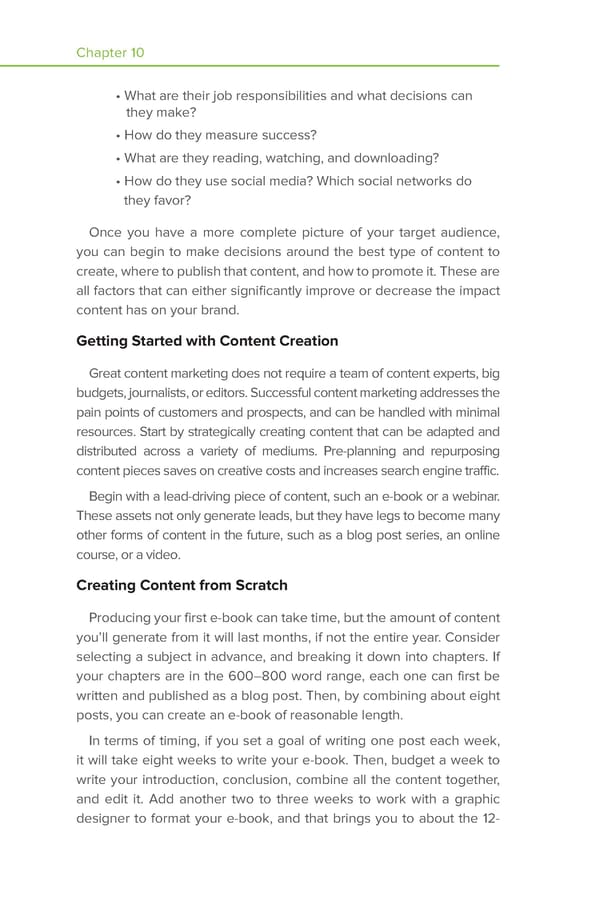
Chapter 10 Filling the Funnel with Content Marketing week mark. Using that framework, an organization can produce an e-book per quarter if they plan accordingly. Timeline to Creating an E-book: Weeks 1–8 = Publish one blog post per week. Week 9 = Write a case study or highlight a customer story. Weeks 10–12 = Design, edit, and publish the e-book. Repurposing Existing Content Creating new content can take time, budget, and resources. Instead of trying to sit down and write a whole new piece, consider selecting a subject in advance, and pulling from content you already have. Whether it’s a case study, an existing blog, or a webinar, take the content and repackage it into a great e-book. For example, one e-book could consist of the following existing content: • Three case studies • Five blog posts • 30 tweets • One transcribed webinar • One transcribed presentation from an event Another great way to pull together an e-book is to curate user- generated content. There are a variety of ways to do this, but below are some solid ideas to help you get started: • Email or call 5–10 experts or influencers in your market and briefly interview them about a particular question or topic. Pull their answers together into an e-book. • Crowdsource an answer to one question on Twitter, gather 10–20 tweets as an e-book of helpful tips. • Co-brand an e-book with another organization. Choose one that offers a product that blends well with yours, has a similar audience, and knows how to create content. Write a new introduction and conclusion to package and harmonize the existing content together, and boom, you have a new e-book!
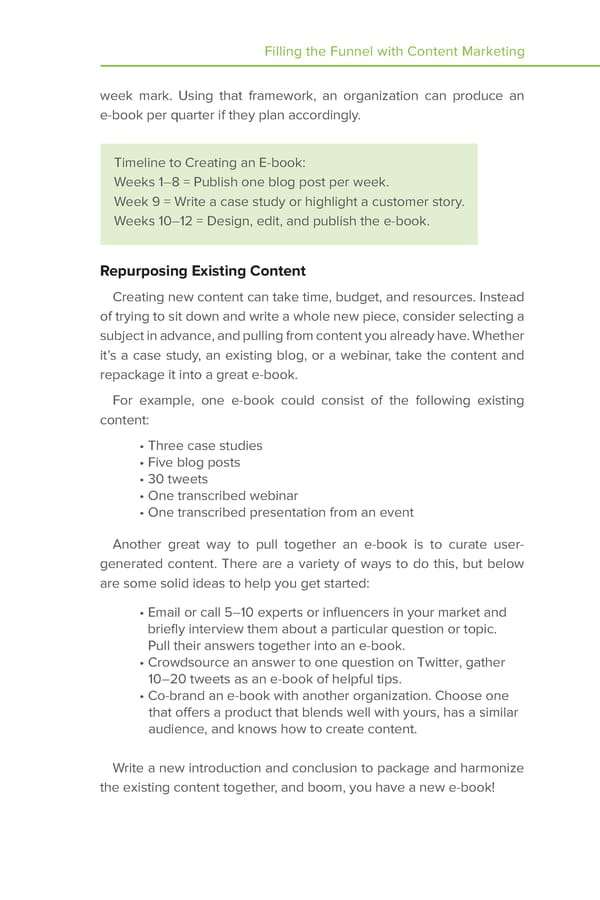
Chapter 10 Filling the Funnel with Content Marketing Filling the Funnel One quality piece of content, like an e-book, can be utilized within the different stages of the sales funnel. Activating your content this way ensures longevity of the piece, and creates consistency for the customer throughout their journey. • Helpful, insightful c ontent Top of Funnel throughout • Not selling • Some product placement Middle of Funnel • Case studies or customer quotes • Link to demo or free trial Bottom of Funnel • Include specific contact info Top-of-Funnel Tactics Your top-of-funnel efforts likely cast a wide net and reach a wide audience. You have some ideas of this audience so you can target accurately, but you might not know them as well as you know your best customer. Therefore, this is the place to slice and dice the most. People digest content in different ways, so the more you chop up and share out your e-book, the more buzz you’ll create. Utilize these top-of-funnel tactics, and make sure to have a link to download your e-book as the call to action: • Post the first chapter on SlideShare. • Record yourself reading the e-book aloud and launch it as an audiobook. • Launch a webinar with the author, featured thought leaders, or relevant brands. • Create an infographic with the e-book’s tips, tricks, or quotes. • Create Twitter cards with quotes, stats, or tips from the e-book. • Host a TweetChat on the topic of the e-book. • Turn each e-book chapter into a blog post. • Contact influencers and ask them to share it out (give them an exclusive sneak preview for even more exposure and buzz). • Guest blog on relevant sites covering the topic of your e-book. • Include the e-book on your website in 2–3 places. Your home page, resources section, or sidebar is a good place to start. • Post it on your product listings.
Chapter 10 Filling the Funnel with Content Marketing • Print it or put it on a USB drive to give away at conferences, booth exhibits, and so on. • Write email and phone scripts about your e-book for cold outreach by sales reps. Middle-of-Funnel Tactics If you’re generating a thought leadership, top-of-funnel e-book, you might think your efforts stop at the top of the funnel, however, that’s not the case. Other departments and audiences can benefit from your e-book, ultimately leading to revenue for your organization, which is likely your end goal, too. The middle of the funnel is where you’ll get existing prospects to raise their hand and move closer to the sale. If you have great content and strong reach, it’s not hard to get net-new leads into your database. A simple download is all you need to get the process started. However, to get them to commit to a demo or free trial takes more work. Your e-book can help. Here are some middle-of-funnel ideas for promoting your e-book: • Work the e-book into your nurture programs or drip campaigns. • Create a content pack for existing prospects, including a case study, e-book, one sheet, and so on. • Include the e-book in your e-newsletter. • Provide the e-book to employees in many ways so it’s easy to access and share: • Chatter file • Landing page link • Direct link • Content library • Ask partners to send it to shared partners and networks. • Print it out or put it on a USB drive, and include it as part of a care package to customers and prospects. • Enter your e-book in marketing contests. Bottom-of-Funnel Tactics The bottom of funnel is where sales takes the lead. Imagine the entire funnel is a road, and you’re in the car driving down it. Marketers are in the driver’s seat for the top and middle of funnel. They control the content, the message, the promotional approach, and so on. But when you reach the bottom of funnel, the salesperson takes the wheel.
Chapter 10 Filling the Funnel with Content Marketing The marketer, however, can’t hop out of the car just yet. Instead, they get in the back seat and help their salesperson close. Here are some ideas for bottom-of-funnel content promotion with e-books: • Attach the e-book to first-call decks. • Write email or phone scripts for existing prospect outreach. • Print it out and give it to salespeople as a takeaway from meetings. As you slice and dice your e-book, you’ll quickly learn what works, and what doesn’t. From there, you can hone in and focus on the successful tactics throughout the funnel. Soon, you’ll have a well- oiled machine for not only creating great e-books, but for successfully activating them and getting eyeballs on their pages. Linking It All Together When you make content marketing a priority, you’re really just making your customers a priority. Great content marketing will help you find customers who remain customers, and who send you more customers down the road. It’s a strategy that can transform your business and help you stand out against competition, the market, and even the world.

